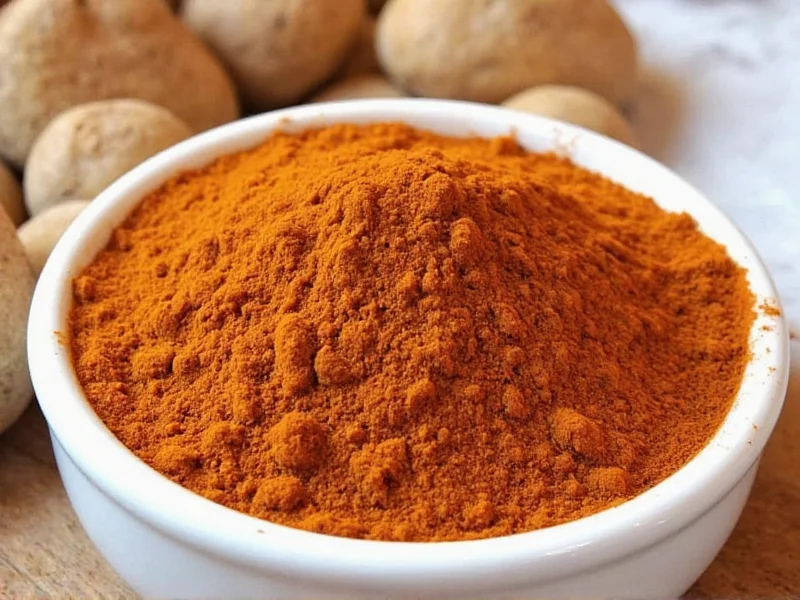Mace, scientifically known as Myristica fragrans, has been prized in global cuisines for centuries. This distinctive spice originates from the same tropical evergreen tree that produces nutmeg, but represents a different part of the fruit. Understanding what spice is mace requires examining its botanical origins and culinary applications.
Botanical Origins of Mace Spice
The nutmeg tree produces a yellow, peach-like fruit that splits open when ripe, revealing a glossy brown nutmeg seed encased in a crimson-red, web-like membrane—this is the mace. Harvesters carefully remove this delicate aril, which is then dried until it transforms into brittle, orange-brown blades. Each nutmeg fruit yields only one piece of mace, making it slightly more expensive than nutmeg itself.
Mace vs Nutmeg: Understanding the Difference
While both spices come from the same fruit, they're fundamentally different components:
| Characteristic | Mace | Nutmeg |
|---|---|---|
| Source | Aril (outer covering) | Seed inside the fruit |
| Color | Bright orange-red when fresh, orange-brown when dried | Brown |
| Flavor Profile | More delicate, with citrus and floral notes | Warmer, earthier, more intense |
| Intensity | Milder (use 25-50% more than nutmeg) | Stronger (use less) |
| Price | Slightly more expensive | Generally less expensive |
Culinary Applications of Mace Spice
Chefs and home cooks value mace for its versatility across both sweet and savory dishes. When exploring what spice is mace good for, consider these applications:
- Baking: Mace enhances pumpkin pie, gingerbread, and fruitcakes with its subtle warmth without overwhelming other flavors
- Savory Dishes: It's essential in classic béchamel sauce, potato salads, and meat stews for complex depth
- Preserves: Adds sophistication to apple butter and spiced jams
- Drinks: Complements mulled wine, eggnog, and spiced cider beautifully
Professional chefs often recommend using whole mace blades for infusions, then removing them before serving. Ground mace works well in dry rubs and baked goods. When substituting between mace and nutmeg, remember that mace has a more delicate flavor—you'll typically need about 25% more mace to achieve equivalent flavor impact.
Historical Significance of Mace
Mace has a fascinating history that explains why understanding what spice is mace reveals so much about global trade. During the 16th and 17th centuries, the Banda Islands in Indonesia were the world's only source of nutmeg and mace, making these spices incredibly valuable. European powers fought vicious wars to control these tiny islands, with mace sometimes trading for more than its weight in gold.
The Dutch went to extreme measures to maintain their monopoly, including destroying trees on other islands and perforating harvested nutmegs to prevent cultivation elsewhere. This historical context helps explain why mace was traditionally considered a luxury spice reserved for special occasions and elite tables.
Storage and Usage Tips
To maximize mace's shelf life and flavor potency:
- Store whole mace blades in an airtight container away from light and heat
- Grind mace just before use for optimal flavor (pre-ground loses potency within 6 months)
- Use mace sparingly in delicate dishes like fish or light sauces where its subtle notes shine
- Toast whole blades lightly before grinding to enhance aromatic compounds
- Pair with complementary spices like cinnamon, cloves, and allspice for complex blends
Nutritional Profile and Health Considerations
While primarily used for flavor, mace offers some nutritional benefits. Research on what spice is mace reveals it contains myristicin, a compound with potential anti-inflammatory properties. A single teaspoon (2g) of ground mace provides:
- Approximately 10 calories
- 1g dietary fiber
- Trace amounts of iron, magnesium, and vitamin B6
- Antioxidants that may support digestive health
As with all spices, moderation is key. Consuming extremely large quantities of mace (several tablespoons) could potentially cause adverse effects due to myristicin content, but normal culinary use presents no health risks for most people.
Common Misconceptions About Mace
Several myths persist about this spice. Understanding what spice is mace helps clarify these misconceptions:
- Misconception: Mace and nutmeg are the same spice
Reality: They come from the same fruit but are different components with distinct flavors - Misconception: Mace is just colored nutmeg
Reality: The vibrant color comes from the natural pigments in the aril, not artificial coloring - Misconception: Mace is significantly stronger than nutmeg
Reality: Mace has a more delicate flavor profile and is generally milder than nutmeg
Where to Find Quality Mace
When shopping for mace, look for:
- Bright orange-red blades (darker indicates age)
- Flexible blades that snap cleanly (brittle indicates old age)
- Whole blades rather than pre-ground for maximum freshness
- Reputable spice merchants who can verify origin and harvest date
High-quality mace should have a sweet, warm aroma with citrus undertones. Avoid any that smell musty or stale, as this indicates loss of volatile oils that carry the distinctive flavor.











 浙公网安备
33010002000092号
浙公网安备
33010002000092号 浙B2-20120091-4
浙B2-20120091-4